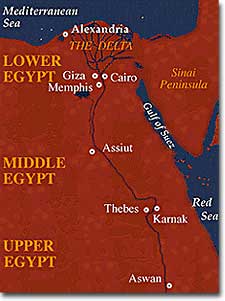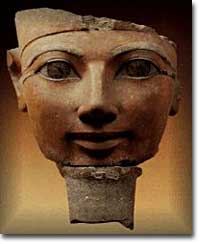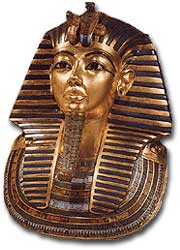The Stability and Continuity of Egyptian History Rested on All of the Following Except

3c. Dynasties

Ancient Egyptian cities which flourished during the Dynastic periods were located close to the Nile River, the life source of the region.
What's a dynasty?
It's a powerful group or family that maintains its position for a number of years. The New York Yankees baseball team of the 1920s is considered a dynasty because they went to the World Series almost every year and had great leaders, such as Babe Ruth and Lou Gehrig.
Ancient Egypt, also had dynasties. They were families who often ruled for a considerable number of years and did impressive things — such as building pyramids — during their rule.
The history of ancient Egypt is divided into three main periods: the Old Kingdom (about 2,700-2,200 B.C.E.), the Middle Kingdom (2,050-1,800 B.C.E.), and the New Kingdom (about 1,550-1,100 B.C.E.). The New Kingdom was followed by a period called the Late New Kingdom, which lasted to about 343 B.C.E. (Intermediate kingdoms — those without strong ruling families — filled the gaps of time in between the Old, Middle, and New Kingdoms.)
During these periods, power passed from one dynasty to another. A dynasty ruled until it was overthrown or there were no heirs left to rule. Each kingdom ended in turmoil either after a period of infighting or after being invaded.
There were more than 30 dynasties in Egyptian history. Dynasties helped keep Egypt united, which was no easy task. Leaders faced periods of chaos, ambitious rivals, and also foreigners who wanted to conquer the region.

All pharaohs wore beards — even female rulers, as shown by this bust of Hatshepsut.
The Earliest Dynasties
Beginning in about 4,000 B.C.E., all of Egyptian society existed in two kingdoms, Upper Egypt and Lower Egypt. Around 3,100 B.C.E., Menes, the king of Upper Egypt, started the long string of dynasties by conquering Lower Egypt. He unified the regions and built his capital city at Memphis, near the border of these two kingdoms. Because Memphis was located on an island in the Nile, it was easy to defend.
So began the first dynasty, an age appropriately called the Early Dynastic Period. Little is known of the pharaohs (rulers) of the early dynasties. The Egyptian word "pharaoh" literally means "great house."
Pharaohs were more than just rulers. They were considered gods and were believed to possess the secrets of heaven and earth. Pharaohs led the government and the army and wielded unlimited power.

The step pyramid of Netjerikhet in Saqqara (left) believed to have been the first pyramid constructed in Egypt, was completed in the 27th century B.C.E. during the Third Dynasty. Pyramid building progressed through the dynasties, culminating in the Pyramids of Giza (right).
The Old Kingdom
About 300 years after Menes united Egypt, its rulers formed a central government in which they held supreme power. This was the beginning of the Old Kingdom. (Kings tend to rule from a central place, which is why the early dynastic period is not considered a kingdom.)

Photo courtesy of State Hermitage Museum
Amenemhat III was one of the great rulers of the Middle Kingdom. During his time as pharaoh, the Pyramid of Hawara was built.
During the Old Kingdom, pyramid building flourished. Cheops had the six-million-ton Great Pyramid of Giza constructed as his tomb. Under Chephren, a Fourth Dynasty ruler, the Great Sphinx was built.
The end of the Old Kingdom was marked by civil wars between pharaohs and nobles.
The Middle Kingdom
Montuhotep II (2,007-1,956 B.C.E.), an Eleventh dynasty pharaoh, was the last ruler of the Old Kingdom and the first ruler of the Middle Kingdom. He and his successors restored political order.
The Middle Kingdom is remembered as a time of flourishing arts, particularly in jewelry making. Egypt became a great trading power during this period and continued massive construction projects. Eventually, the long reign of prosperity gave way to old problems: crop failures, economic woes, dynastic power struggles, and foreign invaders.
Amenemhet III (1817-1772 B.C.E.), of the Twelfth Dynasty, was responsible for the construction of two great projects. He completed the building of the giant waterwheels of the Faiyum region that diverted the floodwaters of the Nile. Amenemhet also constructed the Pyramid of Hawara, which became known as the Labyrinth. It contained about 3,000 rooms.
Trouble struck when a group of foreigners, the Hyksos, a Semitic-Asiatic group, invaded the Nile Delta region. These advanced warriors used new tools for war: bronze weapons and horse-drawn chariots. They defeated the Egyptians, who fought on foot with copper-and-stone weapons.

The New Kingdom
Early pharaohs of the New Kingdom evicted the Hyksos. The New Kingdom is remembered as a time of renaissance in artistic creation, but also as the end of dynastic rule. This period was also marred by corrupt priests and tomb-robbing by government officials.

Tutankhamun may be the most famous of Egypt's pharaohs because of the discovery of his untouched tomb in 1922. The tombs of more prominent pharaohs had been pillaged, but Tut's resting place and its golden treasures had escaped the hands of looters.
A famed pharaoh of the new period was Amenhotep IV, who triggered a religious revolution. Before Amenhotep's rule, Egypt was a polytheistic society that believed in many gods, the most important named Amon. But, Amenhotep believed only in Aton, the sun god. Belief in only one god (monotheism) was a radical notion. To show his devotion to Aton, the pharaoh changed his name to Akenhaton ("he who is loyal to Aton"). Akenhaton moved his capital from Thebes, where Amon was worshipped, to Tell el Amarna.
Naturally, the priests who represented the other gods did not like this change one bit. Many Egyptians also did not like the pharaoh discrediting their gods. After the death of Akenhaton, the powerful priests forced the new capital to be moved back to Thebes .
Tut-Tut
The pharaoh who moved the capital back to Thebes was a boy-king. He ruled for nine years, attempted to pacify the priests, and was responsible for some modest building projects. He began his reign at the age of 10 but died of a head injury at 19.
But, his name is famous: Tutankhamun, or more familiarly, King Tut. Tut is mostly remembered because of his beautiful tomb — one of the very few that was not pillaged by grave robbers.
Ramses II, or Ramses the Great, was another important ruler during this period. He reigned for 67 years and died in about 1,213 B.C.E. at age 96. His nearly 200 wives and concubines bore 96 sons and 60 daughters. Not only did Ramesses build a great family, he also built two temples at Abu Simbel, a covered hall of giant pillars at Karnak, additions at the Luxor Temple, and the Ramesseum, a compound consisting of two temples and a palace.
After Ramses' rule, Egypt fell into steady decline. Today, his 3,000-year-old mummy lies in a display case on the second floor of the Egyptian Museum in Cairo, Egypt's capital.
Over the course of the next nine centuries, the Nubians, the Assyrians, and the Persians bounded into Egypt and ravaged the area. When Pharaoh Nectanebo II retreated to Memphis to avoid death at the hands of oncoming Persian invaders in 343 B.C.E., he became the last Egyptian-born pharaoh, ending over 2,500 years of Egyptian self-rule.
Source: https://www.ushistory.org/civ/3c.asp
0 Response to "The Stability and Continuity of Egyptian History Rested on All of the Following Except"
Post a Comment